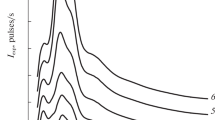Abstract
Aqueous solutions of aluminum chloride in a wide range of concentrations have been studied by X-ray diffraction under standard conditions. It has been demonstrated that aluminum speciation in highly concentrated solutions is dominated by ionic associates involving two chloride ions. As the concentration decreases, the associates first converts to ion pairs and then to independently hydrated ions. The coordination number of the Al3+ ion increases to 6 when the solution is diluted and with an increase in the Al3+–OH2 distance from 0.190 to 0.207 nm. The second coordination sphere of the cation is formed at an average distance of 0.400 nm. The number of solvent molecules in it naturally increases as the solution is diluted. The anion in highly concentrated solutions does not form its own coordination sphere. It begins to form at a distance of 0.315 nm only in solutions of average concentrations.
Similar content being viewed by others
References
E. Gauthier, I. Fortier, F. Courchesne, P. Pepin, J. Mortimer, D. Gauvreau, Environ. Res 84, 234 (2000).
H. Ohtaki and T. Radnai, Chem. Rev. 93, 1157 (1993).
F. Floris, M. Persico, A. Tani, and J. Tomasi, Chem. Phys. 195, 207 (1995).
E. Wasserman, J. R. Rustad, and S. S. Xantheas, J. Chem. Phys. 106, 9769 (1997).
A. Bakker, K. Hermansson, J. Lindgren, M. M. Probst, P. A. Bopp, Int. J. Quantum Chem. 75, 659 (1999).
J. M. Martinez, R. R. Pappalardo, and E. S. Marcos, J. Am. Chem. Soc. 121, 3175 (1999).
M. I. Lubin, E. J. Bylaska, and J. H. Weare, Chem. Phys. Lett. 322, 447 (2000).
A. Lauenstein, K. Hermansson, J. Lindgren, M. Probst, P. A. Bopp, Int. J. Quantum Chem. 80, 892 (2000).
T. Ikeda, M. Hirata, and T. Kimura, J. Chem. Phys. 119, 12386 (2003).
D. Spangberg and K. Hermansson, J. Chem. Phys. 120, 4829 (2004).
T. S. Hofer, B. R. Randolf, and B. M. Rode, Phys. Chem. Chem. Phys. 7, 1382 (2005).
S. Amira, D. Spangberg, and K. Hermansson, J. Chem. Phys. 124, 104501 (2006).
E. J. Bylaska, M. Valiev, J. R. Rustad, and J. H. Weare, J. Chem. Phys. 126, 104505 (2007).
T. S. Hofer, B. R. Randolf, and B. M. Rode, J. Phys. Chem. B 112, 11726 (2008).
T. M. Faro, G. P. Thim, and M. S. Skaf, J. Chem. Phys. 132, 114509 (2010).
P. R. Smirnov and V. N. Trostin, Russ. J. Gen. Chem. 83, 15 (2013). doi 10.1134/S1070363213010039
O. V. Grechin and P. R. Smirnov, Izv. Vyssh. Uchebn. Zaved., Khim. Khim. Tekhnol. 59 (6), 72 (2016).
G. Johansson and M. Sandsrom, Chem. Scr. 4, 195 (1973).
R. Caminiti, G. Licheri, G. Piccaluga, et al., J. Chem. Phys. 71, 2473 (1979).
M. Alves-Marques, M. A. Sousa-Oliveira, and J. Resina-Rodrigues, J. Chem. Soc., Faraday Trans. 86, 471 (1990).
E. Cauët, S. A. Bogatko, E. J. Bylaska, and J. H. Weare, Inorg Chem. 51, 1021 (2012). doi 10.1021/ic301346k
Author information
Authors and Affiliations
Corresponding author
Additional information
Original Russian Text © P.R. Smirnov, O.V. Grechin, 2018, published in Zhurnal Neorganicheskoi Khimii, 2018, Vol. 63, No. 9, pp. 1232–1236.
Rights and permissions
About this article
Cite this article
Smirnov, P.R., Grechin, O.V. Structure of the Nearest Environment of Ions in Aqueous Solutions of Aluminum Chloride According to X-ray Diffraction. Russ. J. Inorg. Chem. 63, 1251–1255 (2018). https://doi.org/10.1134/S0036023618090206
Received:
Published:
Issue Date:
DOI: https://doi.org/10.1134/S0036023618090206




